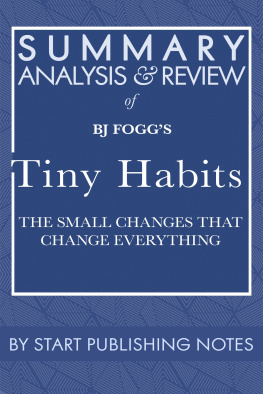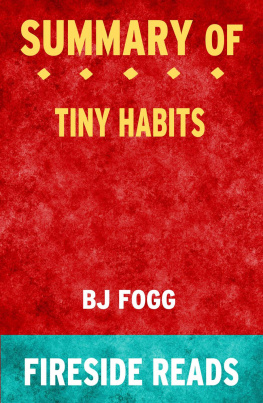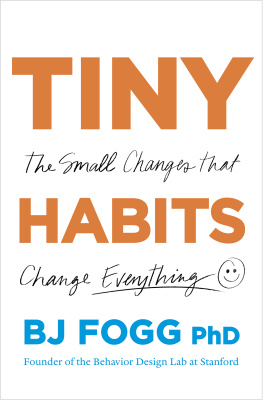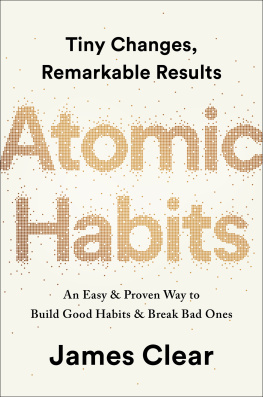Summary
In his book, Tiny Habits: The Small Changes That Change Everything, BJ Fogg explains the drivers of human behavior and offers a roadmap anyone can use to create and sustain the change they want. Creating positive change and building habits, Fogg assures the reader, does not have to be difficult; it can be easy and instinctive, but only with the right approach.
If you have ever struggled to make any habit stickbe it to exercise more, save money, get more sleep, or learn a new skillFogg promises you that it is not because you lacked willpower or discipline; it is because you were working with a flawed design. If you are to create and sustain any form of positive change, you have to understand the elements of human behavior and work with the strengths and limitations of each element.
Any human behavior, Fogg writes, is a function of motivation, ability, and prompts. For you to execute any behavior, you have to be motivated to do that behavior, you have to have the ability to do it, and there must be a prompt or cue to remind or encourage you to do the behavior. If motivation or ability is insufficient or there is no prompt, you wont execute that behavior. The key to creating positive habits and breaking bad habits, then, is to design motivation, ability, and prompts to support the change you want to create.
The first step to creating any successful habit is to clarify what it is you really want to achieve. You cant work with dreams or aspirations because they are too abstract; you have to break them down to small, actionable behaviors. If be more productive is your aspiration, you can clarify it to something like clear my inbox before I leave work. The next step is to identify the behaviors that will support this habit. If one of the reasons you cant clear your inbox is because you are too distracted by social media, one of the behaviors you could have on your list is to switch off your phone or mute notifications when you sit to work.
When you come up with an exhaustive list of behaviors that will support your positive habit, pick two or three behaviors that you know will be effective and that you can do and want to do. Then make these behaviors as tiny as possible. Shrink them to the smallest bit you can do or identify the first step involved in executing them. This tiny behavior or starter step is all you need to focus on to create the positive change you want.
The best way to create sustainable change is to start small because, for one, you can start making tiny changes right nowyou dont have to worry about where you will get the time or how the change will fit in your busy schedule. Tiny changes are also not as intimidating as sweeping changes, so they are easy to execute reliably over time. Every time you execute these tiny changes to perfection (which will be often), you will feel successful, and these positive feelings of success will solidify the habit, increase your resilience, and give you the momentum you need to grow the habit and take on new, unrelated habits.
What really makes tiny behaviors so effective at creating and sustaining long-term change is the fact that they take away the need to rely too much on motivation. Ability and motivation have a compensatory relationship; if you diminish either of them, you will have to make up for it by increasing the other. You cant count on motivation because it comes and goes, but you can count on ability because you have full control over it. If you make a behavior really easy to do, you cover for the unreliability of motivation and, consequently, increase your odds of succeeding at your new habit.
The last element of behavior is arguably the most important becauseunlike motivation or abilityyou cant work around it. Prompts are antecedents, which is to say that they must be present for any behavior to start. Verbal prompts like Collect your toys will get your kids to tidy up, and context prompts like sticky notes on your fridge may be just what you need to stock up on healthy foods. But the prompts that work really well, according to Fogg, are action prompts. Action prompts are behaviors that are already part of your routine. If you tie the new tiny behavior you want to acquire to any of these established behaviors, you increase your chances of executing that behavior. Instead of relying on sticky notes to remind you to buy healthy foods, for example, you could set the intention to pass by the farmers market on your way home from work. Your tiny habit could be something like this: After I buckle in my seatbelt, I will select the route that takes me past the farmers market on my way home. You already drive home from work every evening, so anchoring your new habit to this established habit increases the odds of succeeding at it.
Fogg insists that all behaviorsboth positive and negativeshare the same template, so you can untangle bad habits by redesigning motivation, ability, and prompts. If you redesign your environment in a way that eliminates or undermines the prompts that lead you to engage in a bad habit, you can break that habit. Alternatively, you can find ways to decrease your motivation for doing the undesired behaviors or introduce obstacles that make them harder to do.
Fogg maintains that tiny behaviors compound and grow if you give them time, do them consistently, and celebrate your successes, however small. Two pushups become fifty pushups in good time, and the satisfaction of doing fifty pushups every day becomes the encouragement you need to sign up for a marathon or an online course. Beyond the personal level, tiny behaviors are key to effecting change at home, at work, and in the community. If you find out what people want to achieve, help them clarify their aspirations, assist them to nail down and shrink supportive behaviors, suggest appropriate action prompts, and encourage them to celebrate their successes, you can be an agent of successful long-term change.
Review
BJ Foggs Tiny Habits is a practical guide to making habits that stick. In it, Fogg explains how people can use the principles of Behavior Design to understand and change not just their behavior, but the behavior of other people, as well.
It is no accident that Tiny Habits came out on New Years Eve 2020. The top New Year resolutions for the year, according to systems modeler Bruce Y. Lee, were to lose weight, eat healthier food, exercise more, get into a meaningful relationship, and become better at a skill. But if previous years statistics are anything to go by, a third of the people who made these resolutions fell off the boat by the second week of January, and more than half will not make it to June. Foggs mission is to reverse this trend.
Fogg, who is founder and director of the Behavior Design Lab at Stanford University, explains that most aspirations fail because people dont plan for change in advance, start off with unrealistic targets, or imitate what other people are doing. He insists that the only way people can create change that lasts is to focus on behaviors they already want to do, make those behaviors as small as possible, tie them to some of their established routines, and celebrate every time they execute the behaviors. The Tiny Habits method is brilliant and effective in its simplicity, but short of the few somewhat-novel ideas it unravels, it is nothing groundbreaking. No one is going to bench-press five hundred pounds the day after they decide to be physically fit, and no one will take up a reading hobby at a moments notice. Habits take time, and anyone can guess that starting small and steady always beats hard and fast over the long-term. To Foggs credit, however, this fact isnt always obvious to everyone, otherwise New Years resolutions would have a better success rate.
Fogg is not the first behavioral theorist or writer to propose that people focus on small habits as a way to achieve their aspirations, either. Stephen Guise, who runs MiniHabits.com, has urged his audience to focus on behaviors that are too small to fail for nearly a decade now. In his 2013 book,
Next page








